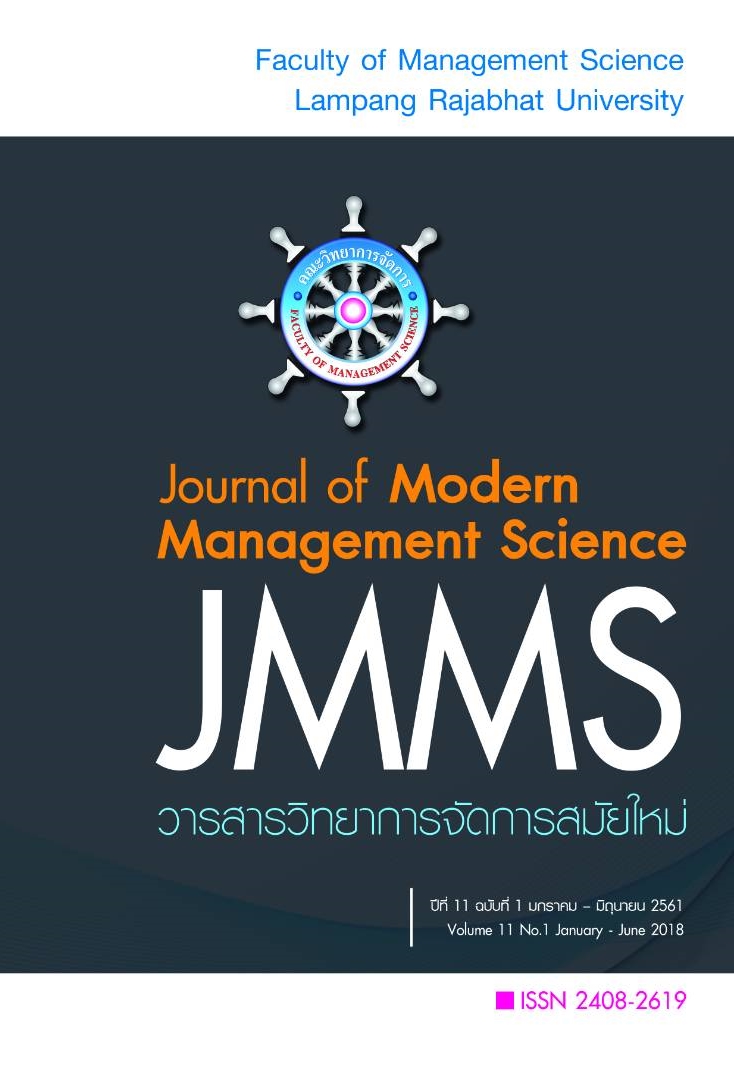A Causal Relationship Model of Adaption Innovation and Modern Technology Accounting Practices, Continuing Professional Accounting Development, Professional Accounting Expertise on Performance Financial Report of Accountant in Thailand
Main Article Content
Abstract
The purpose of research was to study a causal relationship model of adaption innovation and modern technology accounting practices, continuing professional accounting development, professional accounting expertise on performance financial report of bookkeeper in Thailand. The participants were 340 accountants chosen by stratified random sampling. A questionnaire was used as the instrument. Statistics were percentages, mean, standard deviation, pearson correlation, factor analysis, and path analysis was used to find out causal relationship with structural equation models (SEM). The results showed that the measurement model was valid and well fitted to the empirical data (x2 = 51.947, df = 39, p-value 0.08, GFI =0.977, AGFI = 0.947, CFI = 0.994, RMSER=0.031). It showed that this model exhibits acceptable level of fit. In addition, the findings revealed that Adaption Innovation and Modern Technology Accounting Practices, Continuing Professional Accounting Development has the strongest direct effect on professional accounting expertise and the influential factors leading to Professional accounting expertise and performance financial report.
Article Details
The article must be considered and accepted for publication by the editorial board of the Faculty of Management Science, Lampang Rajabhat University. The articles have been reviewed by a peer (peer review) and the author must update according to the suggestion if available before publication. Articles that are not considered the editorial team will inform the results of the consideration but will not send the original to the author.
JMMS is the Faculty of Management Science journal, Lampang Rajabhat University. Jmms published both print and online editions. We allow the use of articles for academic use under the scope of copyright law.
References
ขนิษฐา นิลรัตนานนท์. (2559). ปัจจัยที่มีผลต่อความพร้อมของผู้ประกอบการวิชาชีพบัญชีไทยเพื่อรองรับ
ประชาคมเศรษฐกิจอาเซียน. วารสารวิชาชีพบัญชี, 12(33), 25-39.
ฉัตรรัชดา วิโรจน์รัตน์. (2559). การควบคุมภายในสมัยใหม่เชิงรุกที่มีต่อคุณภาพข้อมูลทางการบัญชีของบริษัท
จดทะเบียน ในตลาดหลักทรัพย์แห่งประเทศไทย. วารสารวิทยาการจัดการสมัยใหม่, 9(2), 26-40.
นวพร ประสมทอง. (2559). โมเดลความสัมพันธ์เชิงสาเหตุระหว่างความคิดสร้างสรรค์ระดับบุคคลสู่นวัตกรรมและความคิดสร้างสรรค์ระดับองค์กรสู่นวัตกรรมกับข้อมูลเชิงประจักษ์. วารสารวิทยาการจัดการสมัยใหม่, 9(2), 49-67.
วัลลภ บัวชุม. (2554). ความรู้ความสามารถด้านเทคโนโลยีสารสนเทศของนักบัญชีไทยตาม IEG 11 ของ
สหพันธ์นักบัญชีนานาชาติ. วารสารวิชาชีพบัญชี, 7(19), 27-39.
สภาวิชาชีพการบัญชีในพระบรมราชูปถัมภ์. (2560). รายชื่อผู้จัดทำบัญชี. [Online] Available:
www.fap.or.th ค้นเมื่อ [2560, มกราคม 2].
โสภณ เพิ่มศิริวัลลภ. (2559). กระแสแห่งนวัตกรรมทางเทคโนโลยีกับวิชาชีพสอบบัญชี. วารสารวิชาชีพบัญชี,
12(34), 59-62.
Abbott, L. J., Parker S., & Peters. G. F. (2004). Audit Committee Characteristics and
Restatements. Auditing-a Journal of Practice & Theory, 23(1), 69-87.
Agrawal, A. & Chadha, S. (2005). Corporate Governance and Accounting Scandals. Journal of
Law and Economics, 48(2), 371-406.
Armstrong, J. S. & Overton, T. S. (1977). Estimating Non-response Bias in Mail Surveys. Journal
Of Marketing Research, 14(3), 396-402.
Banker, R. D., Chang, H., & Kao, Yi-ching. (2002). Impact of Information Technology on
Public Accounting Firm Productivity. Journal of Information Systems, 6(2), 209-222.
Bill, A. H. (2006). Audit Committee Guide: A Source of Information for Audit Committees of
Public Company Boards of Directors. 3rd edition. New York, NY: Bowne.
Byrne, B. M. (1998). Structural equation modeling with LISREL, PRELIS, and SIMPLIS : Basic
Concepts, Applications, and Programming. Mahwah, NJ: Lawrence Erlbaum Associates, Inc.
Carcello, J. V., Hollingsworth C. W., Klein A., & Neal. T. L. (2008). Audit Committee Financial
Expertise, Competing Corporate Governance Mechanisms, and Earnings
Management. Working Paper, University of Tennessee and New York University.
Chen, Y., Chang, B. & Lee, C. (2008). The Association between Continuing Professional Education
and Financial Performance of Public Accounting Firms. The International Journal of
Human Resource Management, 19(9), 17-20.
DeFond, M. L., Hann R. N. & Hu. X. S. (2005). Does the Market Value Financial
Expertise on Audit Committees of Boards of Directors? Journal of Accounting
Research, 43(2), 153-193.
De Lange, P., Jackling, B. & Basioudis, I. G. (2013). A Framework of Best Practice of Continuing
Professional Development for the Accounting Profession. Accounting Education, 22(5),
494.
De Lange, P., Jackling, B. & Suwardy, T. (2015). Continuing Professional Development in the
Accounting Profession: Practices and Perceptions from the Asia Pacific Region. Accounting
Education, 24(1), 41.
Eraut, M. (2004). Informal Learning in the Workplace. Studies in Continuing Education, 26(2),
247–273.
Flaatin, C. (2007). Antecedents of Organizational Creativity and Innovation-
A differentiating perspective. Master Thesis. In Psychology (Autumn), University of Oslo.
Hair, J. F., Black, W. C., Babin, B. J. & Anderson, R. E. (2010). Multivariate Data Analysis :
A Global Perspective. New Jersey: Pearson Prentice Hall.
Hrncir, T. & Metts, S. (2012). Why Small Businesses Fall Victim to Fraud: Size and Trust Issues.
Business Studies Journal, 4(1): 61-71.
Kline, P. (1993). A Handbook of Test Construction. London, UK: Routledge.
Lopez, S. (2012). Examining factors influencing the participation and self-management of
U.S. collegiate women’s rowing coaches in professional development experiences
(Unpublished doctoral dissertation). University of Washington, Seattle, WA.
Metrejean, E., Metrejean, C. T. & Stocks, M. H. (2008). The Effect of the level of
Accounting Degree Obtained on Recruiters’ Perceptions of Accounting Graduates.
Academy of Accounting and Financial Studies Journal, 12, 41-58.
Morunga, M. & Bradbury, M. E. (2012). The Impact of IFRS on Annual Report Length. Australasian
Accounting Business & Finance Journal, 6(5), 47-62.
Nunnally, J. C. & Bernstein, I. H. (1994). Psychometric Theory. New York, NY :
McGraw-Hill.
Robert, L. L. (2001). Whither executive education? Business and Economic Review, 47(3), 3–9.
Sanchez, J. H., Sanchez, Y. H., Collado-Ruiz, D. & Cebrian-Tarrason, D. (2013). Knowledge creating
and sharing corporate culture framework. Procedia-Social and Behavioral Sciences,
74(29), 388-397.
Schumacker, R. E., & Lomax, R. G. (2010). A beginners guide to structural equation modeling.
New York: Routledge.
Sridharan, S. A. (2015). Volatility forecasting using financial statement information. Accounting
Review, 90(5), 2079-2106.
Sunder, S. (2009). IFRS and the accounting consensus. Accounting Horizons, 23(1), 101-111.
Wiroterat, C. Ussahawanitchakit, P. & Muenthaisong, K. (2015). Audit Professional Well-Roundedness and Audit Success: An Empirical Investigation of Certified Public Accountants in Thailand. The Journal of American Business Review, Cambridge, 4(3), 158-180.
Zajkowski, M., Sampson, V., & Davis, D. (2007). Continuing Professional Development: Perceptions from New Zealand and Australian Accounting Academics. Accounting Education, 16(4), 405.


